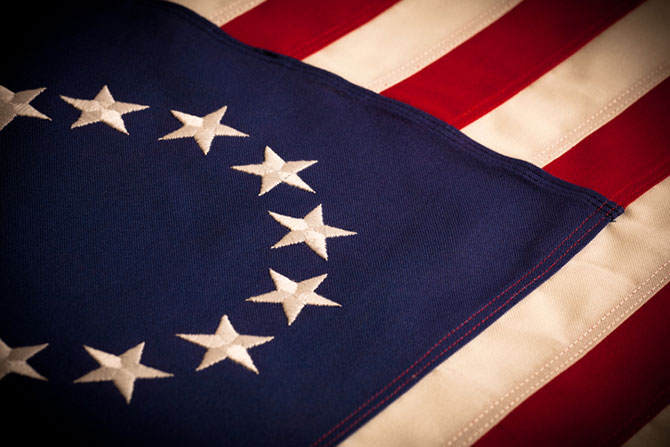The Betsy Ross Flag is probably one of the most recognizable American flags today but, curiously, it wasn’t until the bi-centennial celebrations of 1976 that it became overwhelmingly popular. It was then made the “official” first national flag even though Betsy’s participation in its design is still questionable.
Ross is so beloved and so deeply embedded in the nation’s memory that somehow it seems unpatriotic, if not vaguely treasonous, to cast doubt on her story. The truth, however, is that nobody can prove that Betsy Ross had anything to do with the first official Stars and Stripes. In 1870, her grandson, William Canby, made a speech to the Historical Society of Pennsylvania describing how Betsy came to sew the first American flag for George Washington and her uncle George Ross. According to family tradition, she made the flag we call the Betsy Ross Flag today. The story was then picked up and received national coverage thanks to an article in Harper’s Weekly in 1873.
The problem? Though Betsy made flags for the Pennsylvania State Navy Board as early as 1777 and continuing through 1816, there is no official record of her making the “first” flag with the round pattern of stars. She knew how to make stars with one snip of the scissors, but there is no proof she did so for the flag in question. So, the story is simply an undocumented but interesting American tradition.
How do these stories become so mixed up in family histories? Human nature plays a large part. An old flag is found, and a son asks a father a question. His father says, “I think this was your great grandfather’s and did you know that he fought in the Revolutionary War?” The son passes down the story with embellishments, and a family legend is born. A flag with an already honorable story is backdated to an earlier time and eventually the false story becomes the accepted one.
The Continental Congress recognized that a new nation needed a flag. On June 14, 1777, it passed the country’s first flag law. “Resolved. That the flag of the United States be thirteen stripes, alternate red and white; that the Union be thirteen stars, white on a blue field, representing a new constellation.” Note that the law said nothing about the flag’s size or shape, ordering of the stripes, or the size, type or arrangement of the stars. This lack of guidance resulted in many variations in subsequent flags. For instance, the stars were often five, six or seven pointed.




